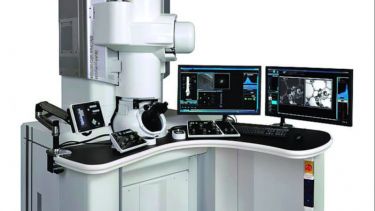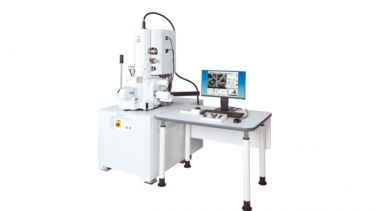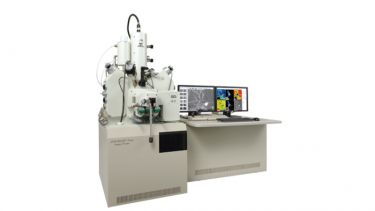Electro Microscopy
EQUIPMENT LIST:
| JEOL | JEM-F200 |
| JEOL | JSM-7900F |
| JEOL | JXA-8530F PLUS |
JEOL JEM-F200
Multipurpose field emission transmission electron microscope with high spatial resolution and improved analytical performance.
USES/APPLICATIONS
The F200 is capable of high sensitivity and resolution materials analysis.
DETAILED DESCRIPTION
The JEOL TEM-F200 is a 200kV S/TEM equipped with a Cold Field Emission Gun for high brightness and a narrow energy spread, supporting high energy resolution electron energy loss spectroscopy (EELS). Dual Silicon Drift Detectors (SDD) enable high sensitivity and throughput X-ray analysis.
The F200 features:
- A quad lens condenser system to independently control intensity and convergence angle,
- The SpecPorter automated sample holder transfer system,
- A PicoStage to carry out precise sample movements, and
- A GATAN OneView camera to provide 16 megapixel imaging and video capabilities for TEM.
DETAILED SPECIFICATIONS
- Accelerating voltages of 200 and 80kV
- Improved Cold FEG with narrow energy spread
- Quad lens condenser system
- SpecPorter automated sample holder transfer system
- GATAN OneView camera
- Dual Silicon Drift Detectors
- GATAN Quantum GIF
- TEM/STEM Tomography holder
LOCATION
Sorby Centre for Electron Microscopy, The University of Sheffield North Campus, Kroto Research Institute, Broad Lane, Sheffield, S3 7HQ
Return to Equipment List
JEOL JSM-7900F
Unique flexible platform that combines the ultimate in high resolution imaging with unparalleled nano scale microanalysis. This tool excels in lightning fast data acquisition through simple and semi-automated operation.
USES/APPLICATIONS
Applications include imaging and analysis of metals, magnetic materials, semiconductors, ceramics, medical devices, and biological specimens.
DETAILED DESCRIPTION
The JSM-700F is equipped with a large specimen chamber that accommodates a wide variety of detectors simultaneously, including:
- Secondary and back scattered electron imaging detectors,
- EDS for chemical analysis [Oxford Instruments Aztec Xmax-170],
- EBSD for orientation mapping [Oxford Instruments Aztec HKL Advanced Symmetry System],
- Transmission Bright-field,
- Dark field STEM capabilities.
The un-lens Schottky field emission gun (FEG) provides improved brightness, smaller probe sizes with increased probe current for improved analytical performance.
The Super Hybrid lens enables observation of specimens at ultra-high spatial resolution including magnetic and insulating materials.
The new Gentle Beam Super High mode (GBSH) enables a bias voltage of up to 5 kV to be applied to the specimen stage, which decreases charging on nonconductive specimens; improves spot size at low kV; enhances surface tomography; and further enables high-resolution imaging at extremely low voltages.
DETAILED SPECIFICATIONS
- Resolution: 7Å @ 1 kV, 6Å @15 kV, 6 Å in STEM
- Analytical resolution sub 30 nm scale
- Probe current > 500nA
- High sensitivity BE detector providing exceptional performance at low accelerating voltages
- Ultralow kV in-lens detectors
- GBSH-S (GENTLEBEAMTM Super High mode) enabling high resolution imaging at extremely low accelerating voltages (down to 10V)
- In-lens Schottky Plus field emission electron gun and low aberration condenser lens provide high levels of brightness
- Super Hybrid Lens (SHL), a combination of electrostatic and electromagnetic lenses, to support ultra high resolution imaging and analysis of various samples ranging from magnetic materials to insulators
- Ample prove current is available at low accelerating voltage, supporting various applications from high resolution imaging to high speed elemental mapping
- A new sample exchange system is designed to change samples in a safe, speedy, seamless manner through simple operations
- Oxford Instruments Aztec Live Energy Advanced Xmax170 X-Ray EDS System
- Oxford Instruments Aztec HKL Advanced Symmetry EBSD System
LOCATION
Sorby Centre for Electron Microscopy, The University of Sheffield North Campus, Kroto Research Institute, Broad Lane, Sheffield, S3 7HQ
Return to Equipment List
JEOL JXA 8530F PLUS
Field emission electron probe micro-analyser (EPMA) with enhanced imaging performance capable of quantitative elemental analysis (Be to U) from regions of interest down to 0.1μm.
USES/APPLICATIONS
High accuracy chemical analysis and elemental mapping of a wide range of solid state materials such as defects, segregation, and identification of trace elements in: conventional and development alloys and ceramics, nuclear glasses, geological materials, archaeological artefacts, and a whole host of potential industrial applications.
DETAILED DESCRIPTION
The JEOL JXA-8530F Plus Hyper Probe, is a state of the art Electron Probe Micro-analyser (EPMA) capable of performing quantitative elemental analysis of small volumes (down to 0.1μm) in solid materials.
The instrument features an In-Lens Schottky Plus Field Emission Gun (FEG) electron source optimised to provide smaller analytical probe diameters at large probe currents, of the order of micro amps, enhancing the available imaging conditions over a wide range of analytical conditions.
The FEG source provides improved secondary electron imaging resolutions: 3nm at 30 kV to 50nm at 10 kV. It is therefore especially suited to performing analysis at lower kV, enabling sub-micron analytical spatial resolution of fine grained features.
The instrument is equipment with 4 X-Ray spectrometers (WDS), three 2 crystal configurations, and one equipped with 4 crystals, providing an analytical range from Be to U.
In addition, the instrument is fitted with a soft X-ray spectrometer (SXES) offering the possibility to study chemical bonding states in light elements.
The JXA-8530F Plus also comes with JEOL's 30mm2 silicon-drift detector (SDD). A high count-rate SDD along with an in-situ variable aperture enables EDS analysis at WDS conditions allowing survey analysis particularly useful for unknown samples.
EDS spectra, maps, and line scans, can be acquired simultaneously with WDS data.
Equipped with a Panchromatic Cathodluminescene (CL) system to enable high speed assessment of minute concentration differences particularly useful for the examination of minerals and mineral-like samples.
DETAILED SPECIFICATIONS
Detectable element range: WDS: (Be*) / B~U, EDS: B~U
Detectable X-Ray range: Detectable wavelength range with WDS 0.087 to 9.3nm /
Detectable energy range with EDS: 20keV
Number of spectrometers: WDS: 5, SXES: 1 EDS: 1 CL: 1
Maximum specimen size: 100mm x 100mm x 50mm (H)
Accelerating voltage: 1 to 30kV (0.1 kV steps)
Probe current range: 10 - 12 to 5x10-7 A
Probe current stability: +/- 0.3%/h
Secondary electron image resolution: 3 nm (W. D. 11mm, 30 kV)
Minimum probe size: 40 nm (10 kV, 1x10-8 A)/ 100 nm (10 kV, 1x10-7 A)
Scanning magnification: x40 to x300,000 (W. D. 11mm)
Scanning image resolution: Maximum 5,120 x 3,840
Large format colour display enabling easy user interface and data analysis.
LOCATION
Sorby Centre for Electron Microscopy, The University of Sheffield North Campus, Kroto Research Institute, Broad Lane, Sheffield, S3 7HQ
Return to Equipment List
ENQUIRE HERE: royce@sheffield.ac.uk



